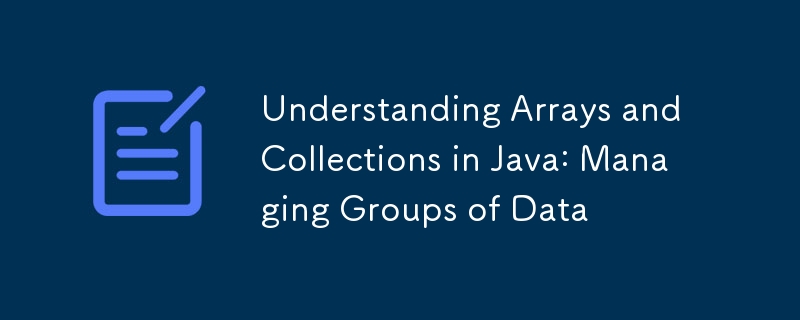

Let’s learn how to work with arrays and collections in Java, essential tools for managing groups of data effectively. This guide covers array basics, ArrayList, HashMap, and more.
In Java, managing groups of data efficiently is crucial for building robust applications. Arrays and collections are two fundamental concepts that help you store, access, and manipulate multiple elements in your programs. This post will guide you through the basics of arrays and collections, including how to use them effectively in your Java projects.
An array is a data structure that holds a fixed number of elements of the same type. It’s like a container that can store multiple values, allowing you to access each value using an index.
You can declare an array in Java by specifying the data type of its elements and using square brackets [].
Syntax:
dataType[] arrayName;
Example:
int[] numbers;
To initialize an array, you must specify its size or provide values directly.
Syntax:
arrayName = new dataType[arraySize];
Example:
numbers = new int[5];
Alternatively, you can declare and initialize an array in a single line:
Example:
int[] numbers = {1, 2, 3, 4, 5};
You can access and modify array elements using their index. In Java, array indices start from 0.
Example:
int[] numbers = {10, 20, 30, 40, 50};
int firstNumber = numbers[0]; // Accessing the first element
numbers[2] = 35; // Modifying the third element
Create an array of 7 days of the week and print each day using a loop.
While arrays are powerful, they have limitations, such as a fixed size. Java's collections framework offers more flexible ways to manage groups of objects. Collections can grow or shrink in size and provide various utilities for working with data.
ArrayList is one of the most commonly used collections in Java. It’s like an array, but it can dynamically resize itself.
Example:
import java.util.ArrayList;
ArrayList<String> fruits = new ArrayList<>();
fruits.add("Apple");
fruits.add("Banana");
fruits.add("Orange");
System.out.println(fruits.get(1)); // Accessing the second element (Banana)
Here are some common operations you can perform with an ArrayList:
Iterating through elements:
for (String fruit : fruits) {
System.out.println(fruit);
}
Create an ArrayList of your favorite books. Add at least 5 books to the list, then print each book using a loop.
HashMap is another powerful collection that stores key-value pairs. It’s ideal for scenarios where you want to associate unique keys with specific values.
Example:
import java.util.HashMap;
HashMap<String, Integer> studentGrades = new HashMap<>();
studentGrades.put("Alice", 85);
studentGrades.put("Bob", 92);
studentGrades.put("Charlie", 78);
System.out.println("Alice's grade: " + studentGrades.get("Alice"));
Iterating through key-value pairs:
for (String student : studentGrades.keySet()) {
System.out.println(student + ": " + studentGrades.get(student));
}
Create a HashMap to store the names and ages of your friends. Add at least 3 friends to the map, then print each name and age.
Use Arrays when:
Use Collections when:
Arrays and collections are fundamental tools in Java for managing groups of data. Arrays offer simplicity and efficiency when working with fixed-size data, while collections provide flexibility and powerful utilities for more complex scenarios.
By mastering these concepts, you can handle data in your Java programs more effectively. Practice with the challenges provided to reinforce your understanding!
The above is the detailed content of Understanding Arrays and Collections in Java: Managing Groups of Data. For more information, please follow other related articles on the PHP Chinese website!




